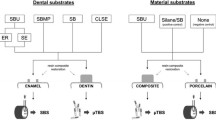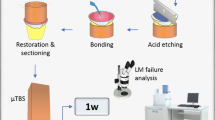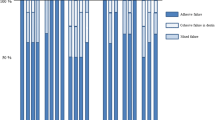Abstract
The pretreatment of dentin with cross-linking agents during bonding procedures has been proposed to improve the mechanical properties of the collagen in the hybrid layer and reduce the biodegradation of the adhesive interface. The aim of this study was to evaluate the influence of pretreatment with two carbodiimides on the dentin bond strength of universal adhesives, after thermocycling. Three universal adhesives in the self-etching mode were used (Single Bond Universal—SBU, Clearfil Universal—CLU and Ambar Universal—ABU). A self-etching adhesive system (Clearfil SE Bond—CSB) was used as control. Two carbodiimides, 1-ethyl-3-(3′-dimethylaminopropyl)-carbodiimide (EDC) and N,N′-dicyclohexylcarbodiimide (DCC), were applied for 1 min. The excess solution was removed with absorbent paper and the universal adhesives were applied. The specimens were stored for 24 h in distilled water at 37 °C or 10,000 thermal cycles (5–55 °C, 30 s) and then were prepared for microtensile bond strength test (n = 4 teeth, average of 21 sticks per group). Data were analyzed using three-way ANOVA and Tukey’s (α = 5%). After 24 h, SBU and CSB had statistically similar bond strength values for the control groups (22.07 ± 9.03 and 19.82 ± 7.28 MPa), with EDC (30.21 ± 11.30 and 19.67 ± 5.36 MPa) and DCC (30.12 ± 13.43 and 19.82 ± 7.28 MPa) pretreatments (p > 0.05). The use of EDC (32.57 ± 9.60 MPa) and DCC (24.71 ± 9.87 MPa) showed statistically higher bond strength for CLU than for the control group (14.62 ± 6.16 MPa; p < 0.05). After thermocycling, the SBU, CLU, and CSB groups showed statistically similar bond strengths with the use of EDC (27.08 ± 8.44; 18.74 ± 5.41; and 24.55 ± 10.43 MPa) and without the use of cross linkers (20.06 ± 7.99; 22.55 ± 9.04; and 26.54 ± 10.13 MPa; p > 0.05). Groups tested after 24 h in distilled water presented higher bond strength than those submitted to thermocycling. It can be concluded that the use of cross linkers influenced the immediate bond strength of the universal adhesives, and this was dependent on the combination of the adhesive system and type of carbodiimide. The use of EDC increased the immediate bond strength of CLU. DCC increased the bond strength of ABU at 24 h, but the values were lower than those of the control group after aging for three out of the four adhesives.

Similar content being viewed by others
References
Asmussen E, Uno S. Adhesion of restorative resins to dentin: chemical and physicochemical aspects. Oper Dent. 1992;17(Suppl 5):68–74.
Carrilho MR, Carvalho RM, Tay FR, Pashley DH. Effects of storage media on mechanical properties of adhesive systems. Am J Dent. 2004;17(2):104–8.
Van Meerbeek B, De Munck J, Yoshida Y, Inoue S, Vargas M, Vijay P, et al. Buonocore memorial lecture. Adhesion to enamel and dentin: current status and future challenges. Oper Dent. 2003;28(3):215–35.
Van Meerbeek B, Inokoshi S, Braem M, Lambrechts P, Vanherle G. Morphological aspects of the resin-dentin interdiffusion zone with different dentin adhesive systems. J Dent Res. 1992;71(8):1530–40. https://doi.org/10.1177/00220345920710081301.
Perdigao J, Munoz MA, Sezinando A, Luque-Martinez IV, Staichak R, Reis A, et al. Immediate adhesive properties to dentin and enamel of a universal adhesive associated with a hydrophobic resin coat. Oper Dent. 2014;39(5):489–99. https://doi.org/10.2341/13-203-LR.
Hanabusa M, Mine A, Kuboki T, Momoi Y, Van Ende A, Van Meerbeek B, et al. Bonding effectiveness of a new ‘multi-mode’ adhesive to enamel and dentine. J Dent. 2012;40(6):475–84. https://doi.org/10.1016/j.jdent.2012.02.012.
Perdigao J, Loguercio AD. Universal or multi-mode adhesives: why and how? J Adhes Dent. 2014;16(2):193–4. https://doi.org/10.3290/j.jad.a31871.
Breschi L, Mazzoni A, Ruggeri A, Cadenaro M, Di Lenarda R, De Stefano DE. Dental adhesion review: aging and stability of the bonded interface. Dent Mater. 2008;24(1):90–101. https://doi.org/10.1016/j.dental.2007.02.009.
Hashimoto M, Tay FR, Ohno H, Sano H, Kaga M, Yiu C, et al. SEM and TEM analysis of water degradation of human dentinal collagen. J Biomed Mater Res B Appl Biomater. 2003;66(1):287–98. https://doi.org/10.1002/jbm.b.10560.
Bedran-Russo AK, Vidal CM, Dos Santos PH, Castellan CS. Long-term effect of carbodiimide on dentin matrix and resin-dentin bonds. J Biomed Mater Res B Appl Biomater. 2010;94(1):250–5. https://doi.org/10.1002/jbm.b.31649.
Pashley DH, Tay FR, Yiu C, Hashimoto M, Breschi L, Carvalho RM, et al. Collagen degradation by host-derived enzymes during aging. J Dent Res. 2004;83(3):216–21. https://doi.org/10.1177/154405910408300306.
Tezvergil-Mutluay A, Mutluay MM, Agee KA, Seseogullari-Dirihan R, Hoshika T, Cadenaro M, et al. Carbodiimide cross-linking inactivates soluble and matrix-bound MMPs, in vitro. J Dent Res. 2012;91(2):192–6. https://doi.org/10.1177/0022034511427705.
Tjaderhane L, Larjava H, Sorsa T, Uitto VJ, Larmas M, Salo T. The activation and function of host matrix metalloproteinases in dentin matrix breakdown in caries lesions. J Dent Res. 1998;77(8):1622–9. https://doi.org/10.1177/00220345980770081001.
Mazzoni A, Pashley DH, Nishitani Y, Breschi L, Mannello F, Tjaderhane L, et al. Reactivation of inactivated endogenous proteolytic activities in phosphoric acid-etched dentine by etch-and-rinse adhesives. Biomaterials. 2006;27(25):4470–6. https://doi.org/10.1016/j.biomaterials.2006.01.040.
Campos EA, Correr GM, Leonardi DP, Barato-Filho F, Gonzaga CC, Zielak JC. Chlorhexidine diminishes the loss of bond strength over time under simulated pulpal pressure and thermo-mechanical stressing. J Dent. 2009;37(2):108–14. https://doi.org/10.1016/j.jdent.2008.10.003.
Carrilho MR, Carvalho RM, de Goes MF, di Hipolito V, Geraldeli S, Tay FR, et al. Chlorhexidine preserves dentin bond in vitro. J Dent Res. 2007;86(1):90–4. https://doi.org/10.1177/154405910708600115.
Hebling J, Pashley DH, Tjaderhane L, Tay FR. Chlorhexidine arrests subclinical degradation of dentin hybrid layers in vivo. J Dent Res. 2005;84(8):741–6. https://doi.org/10.1177/154405910508400811.
Nishitani Y, Yoshiyama M, Wadgaonkar B, Breschi L, Mannello F, Mazzoni A, et al. Activation of gelatinolytic/collagenolytic activity in dentin by self-etching adhesives. Eur J Oral Sci. 2006;114(2):160–6. https://doi.org/10.1111/j.1600-0722.2006.00342.x.
Frassetto A, Breschi L, Turco G, Marchesi G, Di Lenarda R, Tay FR, et al. Mechanisms of degradation of the hybrid layer in adhesive dentistry and therapeutic agents to improve bond durability—a literature review. Dent Mater. 2016;32(2):e41-53. https://doi.org/10.1016/j.dental.2015.11.007.
Cai J, Palamara JEA, Burrow MF. Effects of collagen crosslinkers on dentine: a literature review. Calcif Tissue Int. 2018;102(3):265–79. https://doi.org/10.1007/s00223-017-0343-7.
Bedran-Russo AK, Pereira PN, Duarte WR, Drummond JL, Yamauchi M. Application of crosslinkers to dentin collagen enhances the ultimate tensile strength. J Biomed Mater Res B Appl Biomater. 2007;80(1):268–72. https://doi.org/10.1002/jbm.b.30593.
Parise Gre C, Pedrollo Lise D, Ayres AP, De Munck J, Tezvergil-Mutluay A, Seseogullari-Dirihan R, et al. Do collagen cross-linkers improve dentin’s bonding receptiveness? Dent Mater. 2018;34(11):1679–89. https://doi.org/10.1016/j.dental.2018.08.303.
Comba A, Maravic T, Villalta V, Tozzola S, Mazzitelli C, Checchi V, et al. Effect of an ethanol cross-linker on universal adhesive. Dent Mater. 2020;36(12):1645–54. https://doi.org/10.1016/j.dental.2020.10.004.
Scheffel DL, Delgado CC, Soares DG, Basso FG, de Souza Costa CA, Pashley DH, et al. Increased durability of resin-dentin bonds following cross-linking treatment. Oper Dent. 2015;40(5):533–9. https://doi.org/10.2341/13-211-L.
Zhang Z, Beitzel D, Majd H, Mutluay M, Tezvergil-Mutluay A, Tay FR, et al. Effect of carbodiimide on the fatigue crack growth resistance of resin-dentin bonds. Dent Mater. 2016;32(2):211–22. https://doi.org/10.1016/j.dental.2015.11.024.
Mazzoni A, Angeloni V, Apolonio FM, Scotti N, Tjaderhane L, Tezvergil-Mutluay A, et al. Effect of carbodiimide (EDC) on the bond stability of etch-and-rinse adhesive systems. Dent Mater. 2013;29(10):1040–7. https://doi.org/10.1016/j.dental.2013.07.010.
Angeloni V. Role of collagen cross-linkers on the stability of bonded interface. Università degli studi di Trieste. 2015. http://hdl.handle.net/10077/11800
Davila-Sanchez A, Gutierrez MF, Bermudez JP, Mendez-Bauer ML, Hilgemberg B, Sauro S, et al. Influence of flavonoids on long-term bonding stability on caries-affected dentin. Dent Mater. 2020;36(9):1151–60. https://doi.org/10.1016/j.dental.2020.05.007.
Sinhoreti MAC, Soares EF, Abuna GF, Correr LS, Roulet JF, Geraldeli S. Microtensile bond strength of adhesive systems in different dentin regions on a class II cavity configuration. Braz Dent J. 2017;28(4):474–81. https://doi.org/10.1590/0103-6440201701541.
de la Macorra JC. Statistics: a nuisance, a tool, or a must? J Adhes Dent. 2007;9(5):424.
Mazzoni A, Angeloni V, Comba A, Maravic T, Cadenaro M, Tezvergil-Mutluay A, et al. Cross-linking effect on dentin bond strength and MMPs activity. Dent Mater. 2018;34(2):288–95. https://doi.org/10.1016/j.dental.2017.11.009.
Ayar MK. A review of ethanol wet-bonding: principles and techniques. Eur J Dent. 2016;10(1):155–9. https://doi.org/10.4103/1305-7456.175687.
Gale MS, Darvell BW. Thermal cycling procedures for laboratory testing of dental restorations. J Dent. 1999;27(2):89–99. https://doi.org/10.1016/s0300-5712(98)00037-2.
Hashimoto M, Ohno H, Kaga M, Endo K, Sano H, Oguchi H. In vivo degradation of resin-dentin bonds in humans over 1 to 3 years. J Dent Res. 2000;79(6):1385–91. https://doi.org/10.1177/00220345000790060601.
Miyazaki M, Sato M, Onose H, Moore BK. Influence of thermal cycling on dentin bond strength of two-step bonding systems. Am J Dent. 1998;11(3):118–22.
De Munck J, Van Landuyt K, Peumans M, Poitevin A, Lambrechts P, Braem M, et al. A critical review of the durability of adhesion to tooth tissue: methods and results. J Dent Res. 2005;84(2):118–32. https://doi.org/10.1177/154405910508400204.
Funding
This research did not receive any specific Grant from funding agencies in the public, commercial, or not-for-profit sectors.
Author information
Authors and Affiliations
Contributions
ABFF—formal analysis; investigation; methodology; writing—original draft. RCS—formal analysis; investigation; methodology; writing—original draft. MAM—formal analysis; methodology; writing—original draft. LFd—formal analysis; methodology; writing—review and editing. GMC—conceptualization; project administration; resources; supervision; validation; writing—review and editing. CCG—conceptualization; project administration; resources; supervision; validation; writing—review and editing.
Corresponding author
Ethics declarations
Conflicts of interest
The authors declare that they have no conflicts of interest.
Additional information
Publisher's Note
Springer Nature remains neutral with regard to jurisdictional claims in published maps and institutional affiliations.
Rights and permissions
About this article
Cite this article
Fernandes, A.B.F., Silva, R.C., Müller, M.A. et al. Influence of two carbodiimides on the bond strength of universal adhesives to dentin. Odontology 110, 99–105 (2022). https://doi.org/10.1007/s10266-021-00642-z
Received:
Accepted:
Published:
Issue Date:
DOI: https://doi.org/10.1007/s10266-021-00642-z




